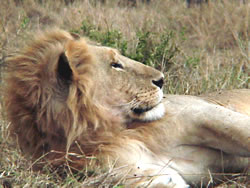 |
|
Lion
lounging during the day
Photo by Bob Plunkett
|
Lions
are on the prowl.
By
day these kings and queens of the food chain are
snoozers lolling in the shade, but when night
falls in the hills that Afrikaners in South Africa
call the bush, the lions arise. These are huge
cats, ferocious carnivores with fangs the size
of fingers and as sharp as spikes, and at night
they're hungry - and searching for supper.
Through
the dark we suddenly find them, their golden coats
shining in the glare of a game tracker's spotlight.
The lions surround our open-top Land Rover in
a hunting party of six gaunt females of various
ages plus one adolescent male, his mane sprigged
in sporadic tuffs around a thick and muscular
neck. We're struck by the size and proximity of
the pride - they're as close as an arm's reach
from my wife Tanya and me as we huddle on exposed
seats in the wagon.
Did
I mention it's very dark?
When
the tracker's light moves away from each lion,
the predator disappears into the blackness, but
we know it's still close because of the sound
of a panting breath and the swooshy snap of tall
grass as enormous claw-packed paws plod through
the brush.
I'm
feeling like a feline hors d'oeuvre served up
on seats of the Rover, just waiting for plucking
by one of the powerful females. Yet our guide
and driver, a South African wildlife expert named
Duard Terreblanche, tells us not to worry about
lions leaping into the vehicle.
"They're
accustomed to seeing the wagons around them, so
they ignore us," Duard whispers. "Besides,
they're on the trail of a more interesting meal."
And
so they are. They're walking, silently but purposefully,
in a line through the bush with perhaps ten yards
separating each hunter.
"We
say they're on their way to McDonald's for supper,"
Duard says, explaining that the lions are probably
stalking the most common hoofed prey in this game
reserve, the Thompson's gazelle, a small but swift
and agile antelope. "You can even see McDonald's
arches in a black 'M' marking the rump of each
gazelle."
As
the lions proceed through the bush we follow in
the Rover, the tracker's light moving from one
cat to another although he's careful not to shine
the light into their eyes or point ahead of the
procession.
"The
light's allowed on the hunters, but we don't want
to give them the advantage by showing off the
prey," Duard tells us.
We
continue like this, a line of lions moving side
by side through the bush but trailed by a Land
Rover filled with spectators who have journeyed
half-way around the world to observe big cats
in the wild.
Then,
as quickly as a twig snaps from shrub, the lions
sprint into the dark.
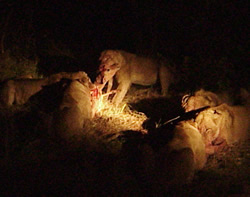 |
Pride
of Lions Surrounding Their Prey
Photo by Bob Plunkett |
Deep
and throaty snarls are heard plus a high-pitched
yelp followed by a loud roar as fangs connect
with forgiving flesh of the antelope trapped by
a wave of pouncing lions. It's not a pretty scene,
and certainly not so to watch one animal die for
the nourishment of others, but it's electrifying
to witness this age-old drama played out by wildlife
in Africa, hunter connecting with the hunted in
the endless continuum of the food chain.
"What
do you want to see the most?" Tanya asks
me during our journey to South Africa and the
private game reserve at Ulusaba.
"I
hope to observe a kill," I tell her, explaining
that, despite being an impassioned proponent of
wildlife conservation, I understand that the struggle
between hunter and hunted and the rule of the
food chain is as much a part of natural order
of Africa as thunderstorms and brush fires. Also,
I want to see Africa's large cats - lions, leopards
and cheetahs, each unique in social behavior and
habits.
We
had already been on safari elsewhere in Africa.
We peered into the gaping mouth of a hippopotamus
on the Zambezi River of Zambia and observed herds
of elephant and giraffe, zebra and wildebeest,
on dusty plains in Zimbabwe.
Yet
we met few big cats on these treks.
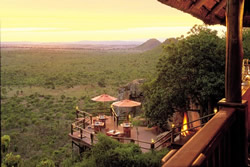 |
Ulusaba
at Sunset
Photo provided by Ulusaba |
One
place that specializes in close encounters with
Africa's wild cats is Ulusaba, a luxurious lodge
and game park owned by Britain's Sir Richard Branson,
the founder of Virgin Airlines.
Ulusaba
amounts to an elegant spa and retreat occupying
high ground in the midst of the Sabi Sand Game
Reserve. Sabi Sand abuts vast Kruger National
Park, which extends for two hundred miles or more
along South Africa's eastern border with Mozambique.
The area boasts the world's greatest concentration
of wild species and it teams with Africa's Big
Five game animals - lion, leopard, cheetah, rhinoceros
and the cape buffalo.
Tanya
and I spent four nights at Ulusaba and discovered
an uncommon safari resort in the wilderness that
caters to adventurous travelers wanting to get
extremely close to African wildlife.
Now
this isn't camping in the bush in the manner of
Hemmingway or Jungle Jim - tents pitched around
a fire pit and lions at bay just beyond the light
of the fire. Rather, accommodations at Ulusaba
more closely resemble a five-star hotel, only
it's located within Africa's largest preserve
of wild animals.
Facilities
consist of two different fortified encampments
- Rock Lodge and Safari Lodge - each a cluster
of thatched-roof bungalows surrounding a spacious
lodge house and gourmet restaurant with adjoining
swimming pool and sun decks. Each compound has
a well-stocked kitchen staffed by chefs trained
in fine cuisine as well as indigenous African
fare. Also, even in such a remote outpost there
are telephone and internet connections, a fitness
center rigged with top-notch equipment, plus the
Aroma Boma Spa, even a tennis court and nearby
private landing strip hacked from dense brush.
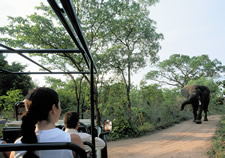 |
Elephant
sighting duriing a morning safari.
Photo provided by Ulusaba |
Daily
routines at Ulusaba revolve around the wildlife,
with early morning and late afternoon forays in
convertible Land Rovers to view the game. Between
these sunup and sundown safaris there's leisure
time for brunch and lounging by the swimming pool
or working out at the gym followed by an indulging
massage at the spa.
After
the evening safari, each lodge hosts a sumptuous
candlelight supper involving multiple courses
and perhaps a taste of wild game such as kudu
or impala.
During
daylight safaris we encounter an ark's assortment
of game - giraffes with their long necks stretching
into thorny acacia trees to munch on tender leaves,
elephants bathing playfully at a water hole as
hippos eye them with only twitching ears and nostrils
evident above the water line, herds of menacing
horns on cape buffalo lurking in shadows of the
bush, or lions, napping in a meadow.
Over
several days we track a lanky female cheetah and
three youngsters as these endangered creatures,
swiftest runners in the animal kingdom, hunt for
impala. One morning, mother parks the kids in
a field, then out-sprints the antelope and holds
its neck in her jaws until the young ones arrive
to render the coup de grace. And as cubs subsequently
feast on the prey, mother cheetah, still panting
from her race, stands over her wards as sentry.
"Uh-oh,"
says Duard as his binoculars pick out the spots
of a leopard lurking in tall grass.
Mother
cheetah also sees the leopard and for ten tense
minutes the two big cats eye one another from
a distance as the cubs devour the little antelope.
We
wait for a confrontation between leopard and cheetah,
but it never comes. Instead, the leopard eventually
slinks off in the grass, with cubs still unaware
of the danger.
"That must be a female," Duard speculates,
"because a male leopard would come right
up and take the kill."
And
one reason the cheetah population continues to
shrink, he says, is because these are Africa's
only large cats that will not stand and defend
a kill.
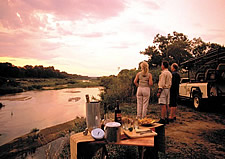 |
Taking
a break from the evening safari.
Photo provided by Ulusaba |
At
sundown during our evening safaris the Land Rover
stops in a meadow as Duard and his tracker, a
Zulu tribesman who uses the Anglican name of Simon,
retrieve from the tail of the Rover a folding
table and picnic basket, then set out refreshments
- high tea of sorts in the bush at Ulusaba.
We
sip and munch while standing around the vehicle,
careful not to stray too far because we've seen
the kind of critters that dwell here.
But
on several afternoons, Duard and the tracker Simon,
each shouldering a powerful hunting rifle, escort
us on a hike into the bush where we physically
place ourselves at risk in the African food chain.
We walk for a mile or so, crossing river and meadow
and following game paths but stopping to observe
even the lowly dung beetle toiling to roll a tiny
ball of elephant dung. Elephants are Africa's
behemoth eating machines, according to Duard,
consuming up to a hundred pounds of fodder every
day but digesting less than half the foliage they
eat. Their droppings, still rich in nutrients,
fuel many other creatures.
Duard
points out the three-foot-long monitor lizard
camouflaged against brown bark of a tree. He picks
off a three-inch-long African chameleon flashing
vivid green skin against the green leaf of a tree,
spies a stately kudu and calf across a clearing
and finds in the sand the tell-tale tracks of
lions, each paw print wider than the span of my
hand.
Near
a water hole our guide discovers the scat from
resident hippos.
"They
venture out of the pools at night to forage, but
watch out because a hippo is the most dangerous
animal in Africa." If a person gets between
a hippo and the sanctuary of its water hole, he
says, the animal will charge, swinging that huge
head back and forth with mouth agape to expose
sharp tusks that can slice a person in half.
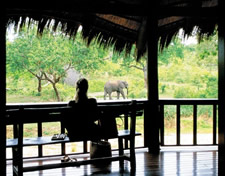 |
Game
viewing from the resort.
Photo provided by Ulusaba |
On
our last evening at Ulusaba, we're in the safari
wagon searching for rhinos.
Shy
and solitary in nature, the white rhinoceros is
elusive at Sabi Sand. We drive around for several
hours looking for these animals that seem as big
as box cars yet all we find are occasional tracks
on the trail plus their spore - lots of spore,
in fact, indicating a very large rhino.
We
return to camp without sighting the creature,
although if we catalog all face-to-face encounters
with the wild things of Ulusaba it amounts to
an incredible show. To prove it, we load the best
images from a digital camera into our laptop computer,
then get on the Internet from a bungalow at Safari
Camp and send home digital post cards.
"Greetings,"
we write, "from the lion's den."
Ulusaba
- safe haven among the wild things
by Tanya Plunkett, Travel
World Syndicate |
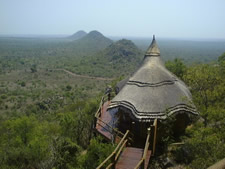 |
Ulusaba's
Rock Lodge
Photo by Bob Plunkett |
The
name Ulusaba means "place of little
fear" because the towering pinnacle
where Rock Lodge stands provided the perfect
lookout point for ancient Shangaan warriors
who once hunted here.
Nowadays
there's little for visitors to fear at Ulusaba,
despite the remote location in a wilderness
populated by the most ferocious animals
in Africa.
But
it didn't seem that way at first.
When
my husband Bob and I arrived at Ulusaba,
following several days on jets from the
United States plus a long ride from the
nearest airport, we spotted a two-track
trail leading out of camp and I asked our
guide, Duard Terreblanche, if that would
be a safe place to run for our daily exercise.
"You
can't run outside the camp," he told
us, "because the lions might get you."
I
thought he must be kidding, although later
I would discover just how many fierce animals
inhabit the seemingly tranquil forests surrounding
Ulusaba's camps.
Duard
suggested we use the gym instead. It's at
Rock Lodge on the granite peak called a
koppie. The highest bungalow, reached by
many steps up a suspended catwalk, houses
Ulusaba's fitness center. We find Cybex
weight-lifting machines, StairMaster steppers
and deluxe treadmills, the type of equipment
stocked by the best gyms in the United States.
So our runs at Ulusaba take place on the
treadmills, which face a floor-to-ceiling
window overlooking a water hole in the forest.
During my first steps on the treads, I watch
as three elephants wade into the pool.
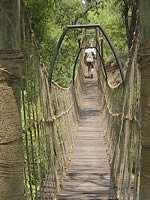 |
Safari
Lodge's Rope Bridge
Photo by Bob Plunkett |
While
Rock Lodge stands atop the koppie, Safari
Lodge is half a mile away built on piers
over banks of the Mabrak River which, except
during the rainy season, resembles a dry
river of rocks. Swinging rope bridges across
the river connect several isolated bungalows
to the main compound. Each camp has an electrified
fence around the perimeter, with boardwalks
and sidewalks linking bungalows to the main
lodge and dining room.
Quarters
at the camps are constructed from stone
and native hardwoods, then decorated in
distinctive colors of a specific African
tribe. A four-poster bed in the wood-floored
room is draped in diaphanous white mosquito
netting, while the spacious bathroom contains
a cave-like shower with cascading waterfall
plus a zebra-striped tub strategically set
near a picture window so you can watch a
parade of game even while soaking.
In
the evening an armed sentry awaits to escort
you to a dinner by candlelight. Still, monkeys
come into the camp through the towering
fig trees and one night a leopard lurked
in granite crevices above Rock Lodge. And
those lions are always out there - we hear
them during the night from our bed, along
with the sing-song bray of the hyena and
honking snorts from hippos.
In
the midst of this menagerie, though, we
find chefs capable of turning out menus
worthy of Michelin's favored stars. A request
for low-fat fare brings the head chef to
our quarters for consultations, and the
meals that follow are creative in selections
and brilliant in execution - including African
stock like the yam and exotic-for-the-bush
spiny lobster.
One
dinner under the stars on decks at Safari
Lodge is interrupted by passing visitors
- a pride of lions meandering across the
river. We watch them from the deck as the
cats fade into the night, then return to
the table with goose bumps tingling.
The
tab for safari at a private game reserve
like Ulusaba may seem steep - about $1,000
in U.S. dollars per night for a couple sharing
quarters. But that fee covers a lot. Included
in the day rate are luxurious accommodations
in a romantic room with en suite bath and
sun deck, the two-per-day game drives with
a ranger and tracker plus optional hikes
on foot into the bush, access to the swimming
pool and fitness center and tennis courts,
all meals and all beverages from a well-stocked
bar including fine wines, even same-day
laundry service with your safari suits starched
and pressed and returned to your quarters
each evening.
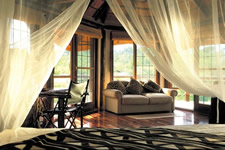 |
Resort
Room
Photo provided by Ulusaba |
Ulusaba,
the private game reserve of Sir Richard
Branson, is situated in the western section
of the Sabi Sand Game Reserve abutting Kruger
National Park in Mpumalanga province of
South Africa. Operating year-round, the
resort consists of two separate camps -
Rock Lodge and Safari Lodge. Accommodations
include all food and beverages, twice daily
game viewing drives, optional walking safaris,
access to lounges, swimming pool, fitness
center and tennis court, plus daily laundry
service.
Per
day rates for two people sharing quarters
begin at 7,000 South African Rand (current
conversion rate of $1,040 in U.S. dollars).
Access
is by charter single-engine aircraft landing
at Ulusaba's private air strip or commercial
air service via South African Airways from
Johannesburg to Kruger Mpumalanga International
Airport, coupled with a car transfer by
road. Johannesburg has daily international
flights from Atlanta, New York, Sao Paulo,
London, Amsterdam, Paris, Frankfurt, Hong
Kong, Singapore and Sidney on such carriers
as South African Airways, Varig, British
Airways, Virgin, KLM, Air France, Lufthansa,
Cathay Pacific, Singapore Airlines and Qantas.
Contact
Ulusaba at the United States office, (800)
557-4255 or (203) 602-0300, or by email
at sanctuare@sanctuare.com. Or visit Ulusaba's
website at www.ulusaba.com |